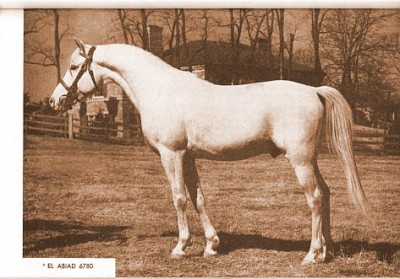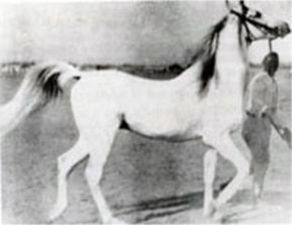The Saqlawi ‘Ajrafi marbat of *Rajwa, a branch of Saqlawi al-‘Abd
One consequence of my re-discovering George Tabet’s booklet after a twenty year hiatus is that it allowed me to solve a couple of puzzles related to Arabian horses imported to the USA.
One of these relates to the 1947 W.R. Hearst desert-bred import *Rajwa and her son the stallion *El Abiad, who was imported by to the USA by F.E. Mars. Rajwa recorded strain is Saqlawi “Ejrifi”. *El Abiad’s is a variant: “Ejrefi”. I had not heard of this marbat of Saqlawi Ejrifi or Ejrefi. I long thought it was a spelling mistake.
Tabet’s bilingual list of Arabian horse strains finally resolved that puzzle. Under the Saqlawiyaat to be mated, it had this:
Saqlawi al-‘Ajrafi/’Ujrufi/’Ejrefi, goes back to Saqlawi al-‘Abd [in the French version: with Turki Ibn Najriss of the ‘Aqaydat]
Here it was, as a branch of the Saqlawi strain, with the exact same spelling as for *Rajwa and *El Abiad, with additional information on the strain and its breeder.
Tabet’s booklet was written in 1937, ten years before the Hearst importation. Tabet’s reference to the Shaykh of the ‘Aqaydat, Turki al-Najriss as the breeder of this strain also provides a clue about *Rajwa’s breeder, given how rare that strain was. I also recall reading somewhere that Hearst’s agent Preston Dyer traveled down the Euphrates valley in search for horses in 1947.
The ‘Aqaydat are a wealthy settled tribe along the Euphrates valley, between Dayr al-Zur and Al Bu Kamal. They way they obtained many of their strains is worth noting. Sba’ah tribesmen, on their winter migration towards the inner Syrian Desert, would typically leave older or crippled mares with a ‘Aqaydat sharik (partner). They would come back to take the foal and either dissolve or renew the partnership. Many precious Sba’ah strains found their way to the ‘Aqaydat in this way.

*Rajwa is indeed typical really looked like some of the pretty ‘Aqaydat mares I saw in Syria in the early 1990s. *El Abiad (above), with his long and elastic neck also bears some resemblance to the Egyptian R.A.S. stallion Nabras (below), a Hadban from the ‘Aqaydat born about 1922.

Saqlawi al-‘Abd, a Ruwallah ‘Anazah strain, in turn goes back to Saqlawi Jadran.
Oh wow! That is exciting!
Yes correctly and I exploring that recently by J?rj F?l?b,Th?bit,Ansa?b al-khayl al-‘Arab?yah
Book.
Saqlawiyah’t al abd originally brfore ibn jadran it was for ibn Bakr al daham from al jabour from Bani Sakhr Tribe and they are kidnapped her from the Slave of ruwala tribe of enaza ( al abd in arabic) when he was ride it her, and it depends or according to the abas Pasha manuscript Which is mentioned below : How to reach the mare to shammar tribe.. We do not know that and the owner (master) of this strain it was ibn bakr from bani shakr.
and anybody can read it and translated from this Web : http://egarabianhorse.bibalex.org/Manuscripts/TextAbbasBasha3.aspx